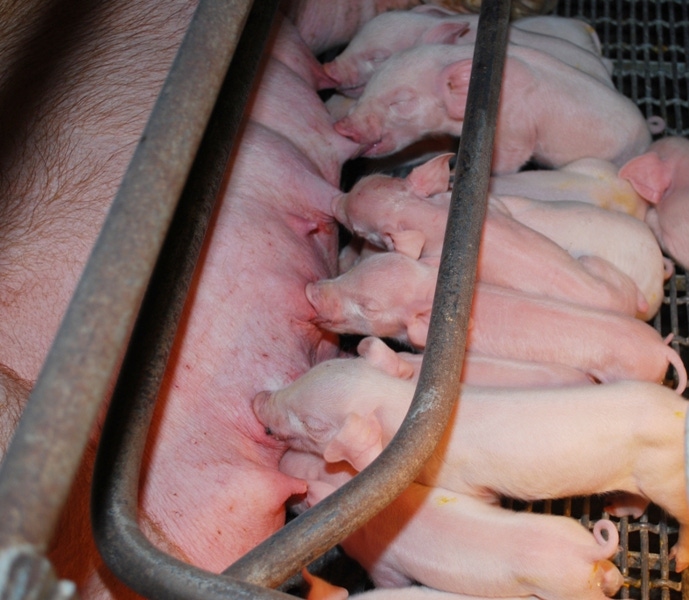Hogs and Pigs Report Suggests Expansion, But PEDV Gets the Last Word

The inventory of all hogs and pigs in the United States on Sept. 1, 2014 was 65.361 million head. This was down 2.3% from Sept. 1, 2013, but up 6% from June 1, 2014. Pre-report estimates had predicted a 3.4% decrease.
Summarizing his thoughts upon the release of the report, Ron Plain, professor of agricultural economics, University of Missouri, Columbia, MO, says, “Across the board, every one of these numbers came in higher than trade expectations, so in my mind, this is a bearish Hogs and Pigs Report.”
Breeding inventory, at 5.92 million head, was up 1.8% from last year, and up 1% from the previous quarter.
Market hog inventory, at 59.441 million head, was down 2.7% from last year, but up 7% from last quarter.
The June-August 2014 pig crop, at 29.539 million head, was down 1.1% from 2013. According to Steve Meyer, Paragon Economics, Adel, IA, analysts had expected that number to be down 2.4%. Sows farrowing during this period totaled 2.907 million head, up slightly from 2013 and close to pre-report estimates. The sows farrowed during this quarter represented 50% of the breeding herd, according to the USDA. The average pigs saved per litter was 10.16 for the June-August period, compared to 10.33 last year. Pigs saved per litter by size of operation ranged from 8.00 for operations with 1-99 hogs and pigs to 10.20 for operations with more than 5,000 hogs and pigs.
Hog producers in the United States intend to have 2.89 million sows farrow during the September-November 2014 quarter, up 4% from the actual farrowings during the same period in 2013, and differing from the pre-report expectations of a 3.2% increase.
Intended farrowings for December-February 2015, at 2.87 million litters, came as a surprise to analysts. The farrowing intention tally is up 4% from 2014, and up 3% from 2013. Prior to the release of the report, analysts had expected only a 1.7% increase over 2014 figures.
The total number of hogs under contract owned by operations with over 5,000 head, but raised by contractees, accounted for 46% of the total United States hog inventory, unchanged from last year.
A team of industry experts summarized their thoughts during a Pork Checkoff-sponsored press conference following the Hogs and Pigs Report’s release. “The industry is making money, so one should expect farrowings to increase and the Report says that is happening. The really bearish numbers in this report are when you get to fall (farrowing) intentions, up 4% and December 2014 to February 2015 farrowing intentions expected to be up 3.8%,” Plain explains. “Those are big increases, and unless we have pigs/litter numbers down due to health reasons and the porcine epidemic diarrhea virus (PEDV), we could start to see some big increases in the pig crop in front of us, and ultimately, big increases in slaughter.”
Daniel Bluntzer, director of research with Frontier Risk Management, Corpus Christi, TX, says the number of pigs saved per litter is a key consideration to the predicted increase in hog numbers. “What is that pigs/litter number going to look like moving forward with the disease problems?” He says even though the pork industry is not going to return to the same pigs-per-litter numbers that were seen prior to the PEDV outbreak for some time, the combination of pigs saved and breeding herd increase could mean a noticeable increase in slaughter totals in 2015. “With the increase in the total breeding herd, we start looking at slaughter figures up as much as 1-2% in the first quarter, up as much as 5% in the second quarter of next year, and maybe up as much as 8% in the third quarter, and then trailing off to 6.5% in the fourth quarter, assuming that those pigs/litter numbers continue to creep higher,” Bluntzer says. “That is an enormous amount of hogs, year-over-year, and something we probably haven’t seen in a decade or so. At the same time, I think we all have to take it with a grain of salt. Will this come to pass, or are those numbers too large? It does certainly point to a lot more hogs into next year.”
The experts did agree that the unknown in the equation is the impact PEDV may have this winter. “The thing that hit me was the 4% increase in farrowing intentions,” notes Kevin Grier, independent livestock and meat market analyst, Guelph, Ontario, Canada. “That’s got to be the one factor that we all scratch our heads about with regard to the impact of PEDV in terms of trying to pencil out a forecast. Are we going to stick with that 4%, or are we going to see that trimmed dramatically because of PEDV?”
Read the Sept. 26, 2014 USDA Quarterly Hogs and Pigs Report online here.
About the Author(s)
You May Also Like



